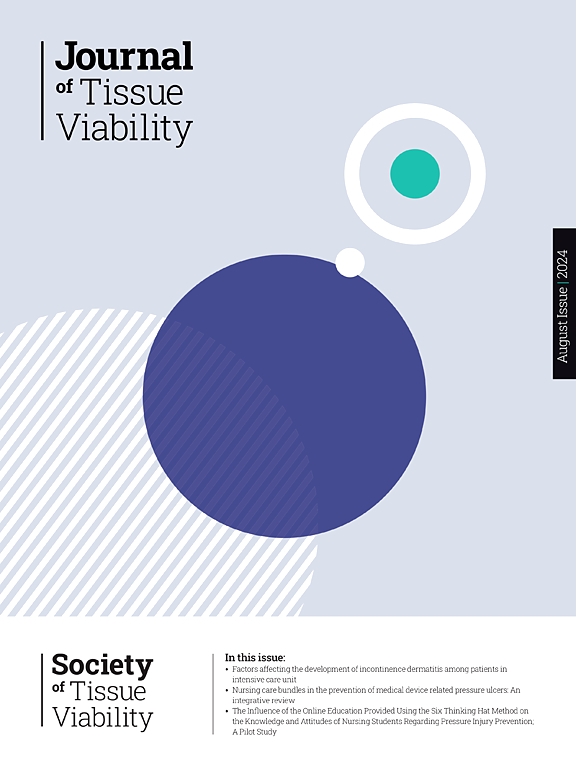Intensive care nurses' knowledge regarding medical device-related pressure injuries and factors affecting these: A descriptive and cross-sectional study
IF 2.4
3区 医学
Q2 DERMATOLOGY
引用次数: 0
Abstract
Aim
Nurses play a fundamental role in preventing, treating, and reducing the incidence of medical device-related pressure injuries (MDRPIs). Therefore, assessing their level of knowledge on this subject is of utmost importance. The aim of this study is to determine intensive care nurses’ levels of knowledge regarding medical device-related pressure injuries and factors affecting these.
Materials and methods
This descriptive and cross-sectional study was conducted with 156 intensive care unit (ICU) nurses between October 2023 and March 2024. Data were collected using the Nurses Information Form, Medical Device Related Pressure Injury Knowledge Assessment Test (MDRPI-KAT).
Results
The nurses had a mean score of 9.05 ± 2.54 on the MDRPI-KAT, indicating an overall correct answer percentage of 56.5 %. It was determined that nurses scored the highest in the sub-dimension of “Selection and Suitability of Medical Devices” (87.5 %) and the lowest in the sub-dimension of “Special Patient Groups” (29.5 %). The total MDRPI-KAT score for female nurses is 1.031 times higher than that of male nurses (B = 1.031, p = 0.013). Additionally, nurses with a high school, bachelor's, or postgraduate level of education have a higher total MDRPI-KAT score compared to those with an associate degree (β = 2.393, p = 0.003; β = 2.114, p = 0.005; β = 3.101, p = 0.001). Furthermore, the total MDRPI-KAT score of nurses who believe that a nursing care protocol is necessary for the prevention of MDRPIs is 1.309 times higher than that of those who do not consider it necessary.
Conclusion
This study found that ICU nurses' knowledge regarding MDRPIs were insufficient. We identified gender, education level, and the perceived need for a nursing care protocol for the prevention of MDRPIs as variables that influence nurses' level of knowledge. To enhance nurses' knowledge about MDRPIs and ensure the provision of safe and high-quality skin care, we recommend that intensive care nurses receive continuous and practical training on MDRPIs. This should include innovative educational methods such as simulations and case analyses, as well as the organization of online courses and webinars.
重症监护护士关于医疗器械相关压力损伤的知识及其影响因素:一项描述性和横断面研究
护士在预防、治疗和减少医疗器械相关压力损伤(mdrpi)的发生率方面发挥着重要作用。因此,评估他们在这方面的知识水平是至关重要的。本研究的目的是确定重症监护护士对医疗器械相关压力伤害的知识水平及其影响因素。材料与方法本研究于2023年10月至2024年3月对156名重症监护病房(ICU)护士进行了描述性和横断面研究。采用护士信息表、医疗器械相关压力伤害知识评估测试(MDRPI-KAT)收集数据。结果护理人员MDRPI-KAT平均得分为9.05±2.54分,总体正确率为56.5%。结果发现,护士在“医疗器械选择与适宜性”子维度得分最高(87.5%),在“特殊患者群体”子维度得分最低(29.5%)。女护士MDRPI-KAT总分是男护士的1.031倍(B = 1.031, p = 0.013)。此外,具有高中、本科或研究生教育水平的护士与具有副学士学位的护士相比,MDRPI-KAT总分更高(β = 2.393, p = 0.003;β = 2.114, p = 0.005;β = 3.101, p = 0.001)。此外,认为护理方案对预防mdrpi是必要的护士的MDRPI-KAT总分比不认为有必要的护士高1.309倍。结论本研究发现ICU护士对mdrpi的认知不足。我们确定了性别、教育水平和预防mdrpi的护理方案的感知需求作为影响护士知识水平的变量。为了提高护士对mdrpi的认识,并确保提供安全和高质量的皮肤护理,我们建议重症监护护士接受关于mdrpi的持续和实用培训。这应该包括创新的教育方法,如模拟和案例分析,以及组织在线课程和网络研讨会。
本文章由计算机程序翻译,如有差异,请以英文原文为准。
求助全文
约1分钟内获得全文
求助全文
来源期刊

Journal of tissue viability
DERMATOLOGY-NURSING
CiteScore
3.80
自引率
16.00%
发文量
110
审稿时长
>12 weeks
期刊介绍:
The Journal of Tissue Viability is the official publication of the Tissue Viability Society and is a quarterly journal concerned with all aspects of the occurrence and treatment of wounds, ulcers and pressure sores including patient care, pain, nutrition, wound healing, research, prevention, mobility, social problems and management.
The Journal particularly encourages papers covering skin and skin wounds but will consider articles that discuss injury in any tissue. Articles that stress the multi-professional nature of tissue viability are especially welcome. We seek to encourage new authors as well as well-established contributors to the field - one aim of the journal is to enable all participants in tissue viability to share information with colleagues.
 求助内容:
求助内容: 应助结果提醒方式:
应助结果提醒方式:


